KansasCity.com's view
BMWs are for folks who love to drive.
Not only do they sit firmly on the road and knife through corners with the precision of plastic surgeon performing a face lift but their engines speak to you through the seat of your pants and the bottom of your right foot. It’s no wonder driving enthusiasts gather at the BMW altar to pay homage to their marque.
The popular 3-Series underwent a major redesign in late 1998, when it appeared as a 1999 model, but only in sedan form. As BMW often does, it introduced one model at a time, and coupe lovers had to make do with the old design for one more year. Now, for 2000, the new coupe, clad in its own unique sheet metal, finally hits the streets. The convertible will be out next spring.
There are two models, the 323Ci and the 328Ci. Prices start at $29,560 for the 323 and $34,560 for the 328. Both use in-line, aluminum, six-cylinder engines with dual overhead cams, four valves per cylinder and variable valve timing. The 323 has a 2.5-liter, 170-horsepower engine while the 328’s 2.8-liter has 193 horsepower.
These engines are as smooth as an electric motor and pull easily throughout the rev range. The larger engine, like the 328 I drove, has the kind of mid-range torque, or pulling power, that reacts to the slightest dab of the throttle with a satisfying surge that makes frequent shifts unnecessary. And that’s a shame, because the five-speed manual transmission has one of the most solid, direct shift linkages on the planet, and using it is a joy.
The optional automatic transmission allows the driver to make shifts manually by tipping the lever forward or back.
Despite the fact that most body panels are different, the coupe has a strong family resemblance to the sedan. Dimensionally, it is roughly 1 inch lower, 1 inch wider and nearly 2 inches longer. The windshield is raked back at a steeper angle for a rakish profile and a sportier stance, befitting its intended customer.
The sleek coupe blends the functionality of a four-seater with the manners of a sports car. Most coupe buyers use the back seat on rare occasions, and when they do their passengers will appreciate a slight improvement in knee room. Being able to fold down the back seat and create a sizable cargo space is one of its most appealing aspects.
In the past, the rear quarter windows opened manually, which meant that most people never used them because reaching clear to the back of the car was inconvenient. This year, they are power operated, which is great.
Our test car was equipped with the Premium Package, which consists of leather upholstery, wood trim, power sunroof and rain-sensing windshield wipers. The seats are not as firm as those in the sport package, but they still do an excellent job of holding you on all sides. The seat belts, mounted on the door pillars, were almost impossible to reach once the door was closed.
The instrument panel layout bears a strong resemblance to the one in the larger 5-Series, especially the way the center section curves out toward the driver. The gauges have a different coloration than those in the sedan, but otherwise they have the same simple design and excellent readability.
The three-spoke steering wheel has fingertip controls for radio and cruise control, but they are marked with international symbols that I find difficult to decipher.
Vehicle dynamics, always a BMW hallmark, are even more a part of the coupe’s personality. The standard suspension pieces are basically the same as the sport suspension of the sedan, which corresponds to a taut, but not tough, ride, almost perfectly weighted steering and ventilated disc brakes that scrub off speed so quickly you feel slightly disoriented if you nail them at 70 mph.
To enhance handling in poor traction situations, such as rain, snow or ice, BMW outfits the coupe with traction control and anti-lock brakes. The Dyna c Stability Control system takes input from various sensors and applies one brake at a time to help keep the car on its path. This unit is invaluable in emergency evasive maneuvers.
Safety equipment includes front and side airbags plus BMW’s Head Protection System, a tubelike airbag that deploys across the side window to protect the head of front-seat occupants in a side impact.
Price
The base price of our test car was $34,560. The light yellow metallic paint, Premium package, Xenon headlamps and AM/FM/CD player brought the sticker price to $38,635.
Warranty
Four years or 50,000 miles. All scheduled maintenance for three years or 36,000 miles is free.
Point: BMW’s coupe is sportier than the sedan, yet it can hold four people in a pinch. It has a tight ride, crisp handling and a delightful six-cylinder engine. The head-protection airbag is a real bonus.
Counterpoint: The seat belts are hard to reach because the doors are wide, and I prefer power window and lock switches on the doors instead of the console, but that doesn’t seem to be the European way.
SPECIFICATIONS:
ENGINE: 2.8-liter, 6-cyl.
TRANSMISSION: Five-speed
CONFIGURATION: Rear-wheel drive
WHEELBASE: 107.3 inches
CURB WEIGHT: 3,197 lbs.
BASE PRICE: $34,560
PRICE AS DRIVEN: $38,635
MPG RATING: 21 city, 29 hwy
Latest news



